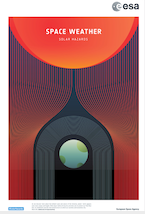Speaker
Description
We introduce a new technique of space weather monitoring using energetic neutral atoms (ENAs), and the instrumentation to achieve the monitoring. ENAs are produced ubiquitously in the solar system through charge exchange interactions between space plasma and ambient particles. Thanks to their neutrality, ENAs fly along ballistic trajectories, keeping the energy and direction information of the original source plasma ion. Thus, ENAs have been used widely to image plasma populations in a remote sensing manner. Such characteristics of ENAs provide potential applications to the space weather monitoring, complimentarily to the other measurement techniques such as in situ plasma measurements and telescopic measurements at various wavelengths. Particular interests of using the ENAs are that they conserve the velocity distribution function of the source plasma ions in the disturbed space weather conditions. Among several possible ENA populations, we here focus on the ENA component that are produced in front of interplanetary coronal mass ejections (ICME). Low to medium energy (1-10 keV) ENAs are produced, transported toward the Earth, arriving a couple of hours before the arrival of the high-temperature plasma cloud (i.e., the main ICME). Since the ENAs can intrude to the terrestrial magnetosphere, ENA sensors at any spacecraft altitudes can detect the corresponding flux. In addition to forecast of the arrival of the main ICME, ENA preserves the velocity distribution function of the ICME plasma. With this information, quantitative assessment of the strength of geoeffective ICME impact becomes possible before their arrival. In the presentation, we introduce an ENA instrument equipping with the ability to monitor the ICME-originated ENA populations, with flight heritages in space, developed at Swedish Institute of Space Physics; including the CENA sensor on Chandrayaan-1 spacecraft (2008), the MPPE/ENA sensor on BepiColombo/MMO spacecraft (2018 launched), and the PEP/JNA sensor on the JUICE spacecraft.

